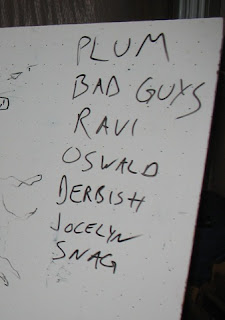Tabletop RPG is not known for being a very physical activity. Most of the action takes place in the mind's eye, and the most exertion that occurs is the process of moving miniatures or rolling dice. Overall, it's a pastime that encourages the player to sit down and relax. But a bit of exercise never hurts, and it is possible to work this kind of activity into your campaign if you want.
Occasional physical challenges are a good idea for a number of reasons. First, they are a pleasant surprise and change of pace from the usual tabletop gameplay. Participating in them also gets the blood flowing again, helping your players to wake up and become more alert. They can also be just plain fun, and create unique experiences that will engage your players in a more direct way than simple dice rolling and narration.
Ideas for physical challenges can most often be found in books and resources for party or parlor games. If you can come up with a way to integrate one of these activities into your campaign, it can become a very memorable session for your gaming group. Just remember to keep them very simple and straightforward.
There are some precautions to be taken as well. Make sure you have taken proper safety precautions before you initiate a physically involved event. Also ensure you have the space to safely move as much as would be required. Watch out for furniture, corners, sharp edges, anything that might get knocked over if this is an activity that requires a lot of movement. Check that your players are fully informed of any rules and restrictions. It's a good idea to clearly prohibit physical contact with other players, climbing over the table, and that sort of thing. You don't want things getting too rambunctious.
Here are a few of the scenarios I have concocted that involved physical activity on the part of the player. In each one, the physical challenge just represents the action occurring in the game world, like an alternative game mechanic to dice rolling.
- I challenged my group with an ice sorceress by throwing rolled-up blue party streamers towards the players. The streamers would unfurl and land harmlessly near players, and they were challenged to catch as many as possible to win the challenge.
- I have another scenario planned involving a performance in a grand ballroom. In order to perform elegantly in the courtly dance, the players must keep a balloon bouncing over their heads by bopping it back and forth between themselves until the music comes to a stop.
- My players played a carnival "crane game" in a magical theme park by picking up and moving playing dice with a set of chopsticks.
- I had a player learn how to fly a space ship by presenting red, yellow, and blue colored cards in specific pattern in order to perform certain maneuvers.
- You might also put your more dexterous player to the test by having them complete a marble maze game (pictured below) or putting together a puzzle.
Physical activity can present another layer to the game if deployed properly. Always make sure your group is going to be receptive to the idea before you implement it. Be aware of any special needs or limitations of the players in your group. Some groups might not be as open to the idea of scenarios being resolved by their own dexterity and strength rather than their character's statistics. It's not the best idea for every group, but for those who would embrace the experience, it will surely be a different kind of adventure.
What kind of party games and activities have you worked into your own campaign? Are there any in particular that would work well at the game table? Sound off in the comments, or post to DMpathy Twitter or Facebook.
Happy ventures!






















